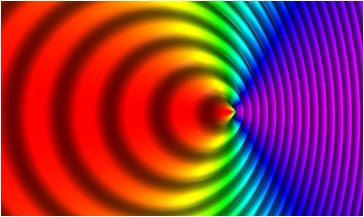Light from distant galaxies is red-shifted, which is how the expansion of the universe is discovered. Red-shifted light has less energy than the originally emitted light, since longer wave lengths carry lower energy. Gamma rays and ultra-violent being more energetic than red and infra-red. Light is photons. What happened to that lost energy? Did it create more photons?
-
Features
-
Friends of IIDBFriends Recovering from Religion United Coalition of Reason Infidel Guy
Forums Council of Ex-Muslims Rational Skepticism
Social Networks Internet Infidels Facebook Page IIDB Facebook Group
IIDB Archives FRDB Archive Secular Café Archive
You are using an out of date browser. It may not display this or other websites correctly.
You should upgrade or use an alternative browser.
You should upgrade or use an alternative browser.
A physics question
- Thread starter lostone
- Start date
Elixir
Made in America
If you visualize the light emitted by that star in a given moment as a rapidly expanding sphere, the surface area of that sphere is constantly expanding and its energy is getting more and more diffuse. The net energy on the surface of that sphere remains constant (minus photons that hit something).
If you stopped moving away from the source though, the redshift would disappear. It’s an apparent/perceived phenomenon dependent on the relative velocities of observer and source.
If you stopped moving away from the source though, the redshift would disappear. It’s an apparent/perceived phenomenon dependent on the relative velocities of observer and source.
steve_bank
Diabetic retinopathy and poor eyesight. Typos ...
Good question and I don't have an answer specifically.
Generally my guess. A distant star to us looks like an isotropic radiator. That is a teoretcal infinitesimally small radiator that radiates energy equally in all directions.
As the sphere of the wavefront expands with distance energy per m^2,energy density, goes down but the total energy crossing the wavefront sphere stays the same. Conservation of energy.
As to the observed red shift that is a relative velocity not an absolute velocity,a Doppler Shift at the observer.
No different tan the sound of a fire engine siren as it approaches then moves away from you, The wavelength does not change your perception of the wavelength or frequency canes.. The energy in the acoustic wave does not change.
Same with Doppler RADAR.
I could be wrong. Try a search on Doppler RADAR wavelength shift energy cnange, or something like hat. Or 'does energy chnge with radio frequncty doppler shft'.
Generally my guess. A distant star to us looks like an isotropic radiator. That is a teoretcal infinitesimally small radiator that radiates energy equally in all directions.
As the sphere of the wavefront expands with distance energy per m^2,energy density, goes down but the total energy crossing the wavefront sphere stays the same. Conservation of energy.
As to the observed red shift that is a relative velocity not an absolute velocity,a Doppler Shift at the observer.
No different tan the sound of a fire engine siren as it approaches then moves away from you, The wavelength does not change your perception of the wavelength or frequency canes.. The energy in the acoustic wave does not change.
Same with Doppler RADAR.
I could be wrong. Try a search on Doppler RADAR wavelength shift energy cnange, or something like hat. Or 'does energy chnge with radio frequncty doppler shft'.
lpetrich
Contributor
The redshifted photons' energy goes into making the Universe expand.
In general, (momentum) ~ 1 / (Universe size factor)
In general, (momentum) ~ 1 / (Universe size factor)
bilby
Fair dinkum thinkum
- Joined
- Mar 6, 2007
- Messages
- 34,090
- Gender
- He/Him
- Basic Beliefs
- Strong Atheist
If you're walking into the wind, the raindrops hit you harder. If you're walking with the wind, they don't hit you as hard.
Same with photons.
Same with photons.
steve_bank
Diabetic retinopathy and poor eyesight. Typos ...
Photon energy is murky. I think the question is whether or not photon energy is absolute or reltive. Photons have no rest mass.
Kinetic energy is relative. Two cars are traversing side by side, observers from either car see no kinetic energy between them. An observer on the ground sees KE = .5mv^2.
A place to start.
The velocity of a photon is always measured as C regardless of the source velocity and velocity of observers,

 www.quora.com
www.quora.com

 en.wikipedia.org
en.wikipedia.org
Looks like my analogy to acoustic and RADAR Doppler shift was wrong. Learn something new every day.
Kinetic energy is relative. Two cars are traversing side by side, observers from either car see no kinetic energy between them. An observer on the ground sees KE = .5mv^2.
A place to start.
The velocity of a photon is always measured as C regardless of the source velocity and velocity of observers,

Is the kinetic energy content of a photon an absolute quantity or a relative one?
Answer (1 of 2): The kinetic energy of a photon is relative, not absolute. That’s because the kinetic energy of a photon is inversely proportional to its wavelength. Whilst the velocity of a photon is not affected by the relative velocity of the source and observer, the wavelength is. If the sour...
Profile photo for Steve Jones
Steve Jones
Studied at Imperial College LondonAuthor has 12.3K answers and 24.1M answer views5y
The kinetic energy of a photon is relative, not absolute. That’s because the kinetic energy of a photon is inversely proportional to its wavelength. Whilst the velocity of a photon is not affected by the relative velocity of the source and observer, the wavelength is. If the source of light is moving away from the observer sees it as “red shifted” with a longer wavelength, and therefore with lower energy, whilst the opposite happens if the source is moving towards observer.
This is due to something called the Relativistic Doppler Shift. Whilst the effect is nominally similar to the “everyday” Doppler Shift we observe with sound from moving vehicles, it’s due to a somewhat different relativistic effect.
248 viewsView upvotes

Relativistic Doppler effect - Wikipedia
The relativistic Doppler effect is the change in frequency, wavelength and amplitude[1] of light, caused by the relative motion of the source and the observer (as in the classical Doppler effect), when taking into account effects described by the special theory of relativity.
The relativistic Doppler effect is different from the non-relativistic Doppler effect as the equations include the time dilation effect of special relativity and do not involve the medium of propagation as a reference point. They describe the total difference in observed frequencies and possess the required Lorentz symmetry.
Astronomers know of three sources of redshift/blueshift: Doppler shifts; gravitational redshifts (due to light exiting a gravitational field); and cosmological expansion (where space itself stretches). This article concerns itself only with Doppler shifts.
Looks like my analogy to acoustic and RADAR Doppler shift was wrong. Learn something new every day.
Elixir
Made in America
Hey, only slightly, as good analogies always are.Looks like my analogy to acoustic and RADAR Doppler shift was wrong. Learn something new every day
steve_bank
Diabetic retinopathy and poor eyesight. Typos ...
At Earth bound relative velocities relativistic effects maybe insignificant for Doppler RADAR. I don't remember it in the texts.
I wondered in the past how time dilation factored into cosmology, now I know.
I wondered in the past how time dilation factored into cosmology, now I know.
Shadowy Man
Contributor
The energy isn’t “lost” per se. You are viewing it from a different reference frame so it has a different energy.
If you are in a car moving at some velocity you don’t have kinetic energy from your reference frame in the car, but someone viewing you from a fixed position on the sidewalk sees you have kinetic energy. If you are both in inertial reference frames neither of you is wrong. Which of you has the energy?
The universal expansion results in having non-universal reference frames. When aliens in that distant galaxy see our light they will ask the same question.
If you are in a car moving at some velocity you don’t have kinetic energy from your reference frame in the car, but someone viewing you from a fixed position on the sidewalk sees you have kinetic energy. If you are both in inertial reference frames neither of you is wrong. Which of you has the energy?
The universal expansion results in having non-universal reference frames. When aliens in that distant galaxy see our light they will ask the same question.
Don2 (Don1 Revised)
Contributor
The universal expansion results in having non-universal reference frames. When aliens in that distant galaxy see our light they will ask the same question.
This is why they're wrong and we should conquer them.
